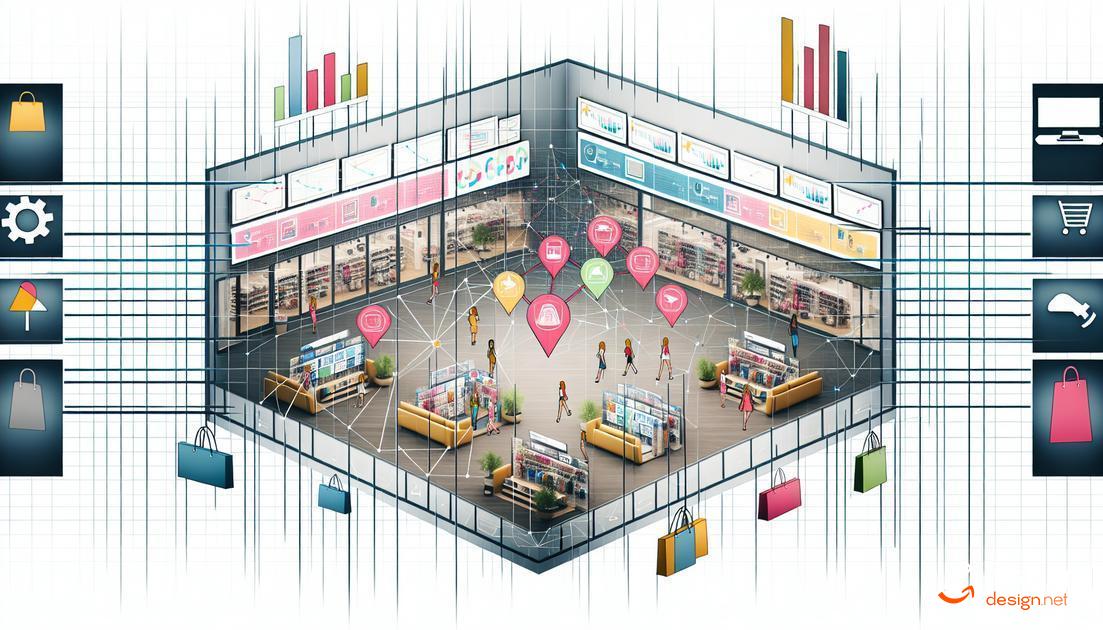Retail Media Networks are rapidly changing the landscape of digital marketing. By leveraging these networks, retailers and brands can tap into new revenue streams while simultaneously enhancing customer engagement. Understanding the benefits, challenges, and strategies associated with Retail Media Networks is crucial for staying competitive in today’s market.
Table of Contents
The Rise of Retail Media Networks
Over the past few years, Retail Media Networks have transformed the advertising landscape within the retail sector. These networks leverage a retailer’s first-party data and digital presence to create valuable advertising opportunities for brands. Retailers, owning vast troves of customer data, can now offer highly targeted advertising placements both on their websites and through offsite channels.
The rise of e-commerce and the decline of third-party data reliability due to privacy regulations have accelerated the growth of retail media. Not only do these networks provide alternative revenue streams for retailers, but they also enable brands to reach consumers at critical points in their shopping journeys. This strategic shift capitalizes on existing customer relationships, making the ad placements more effective and relevant.
Moreover, retail media networks are becoming an integral part of the digital marketing ecosystem, bridging the gap between online and offline consumer behaviors. By integrating closely with in-store data and digital touchpoints, these networks offer a cohesive view of the customer, allowing for seamless ad targeting and improved ROI.
Ad Inventory Expansion
As retailers embrace this concept, they are expanding their ad inventory to include various formats like sponsored product listings, display banners, video ads, and native content. This diversification helps in capturing consumer attention across different stages of their purchasing decision process.
Data-driven insights are another critical component, allowing for precise ad targeting and campaign optimization. The ability to personalize ads based on purchase history, browsing behavior, and demographic information enhances campaign performance significantly.
The continuous rise of these media networks is reshaping the retail landscape, driving innovation, and offering unprecedented opportunities for brands and retailers alike.
How Retail Media Networks Work

Retail media networks operate by transforming retailer-operated digital platforms into advertising spaces, providing brands with the opportunity to reach shoppers at key points along the purchasing journey.
Ad Placement Opportunities
There are multiple ad placement opportunities within these networks, including on retailer websites, mobile apps, in-store digital displays, and email campaigns. These placements can be tailored to target specific customer segments based on shopping behavior and purchase history.
Data-Driven Advertising
Retail media networks leverage first-party data collected by the retailer to offer highly targeted advertising. This data helps brands to deliver personalized ads that resonate with individual shoppers, boosting engagement and conversion rates.
Programmatic Buying
Many retail media networks support programmatic buying, allowing brands to automate the purchasing of ad space in real-time. This technology enhances the efficiency of ad spend by ensuring that ads are shown to the right audience at the optimal time.
Revenue Sharing Models
Revenue sharing models are often employed in retail media networks, where retailers take a percentage of the ad revenue generated on their platforms. This creates a mutually beneficial relationship between retailers and advertisers.
Effective campaign measurement is critical, and metrics such as impressions, click-through rates, and conversion rates are regularly monitored to refine strategies and improve outcomes. Retail media networks represent a potent tool for both retailers and brands alike, driving growth and enhancing shopper experiences.
Benefits for Retailers
By leveraging retail media networks, retailers can transform their digital platforms into powerful advertising channels. This initiative not only boosts the overall shopper experience but also opens up a valuable revenue stream. As retailers integrate ads seamlessly into their ecosystems, they capture consumer attention at pivotal moments in the purchasing journey.
Enhanced Customer Insights: Retail media networks provide retailers with rich consumer data. This data can be leveraged to improve product offerings, personalize marketing efforts and optimize inventory management. By understanding customer behavior, retailers can tailor their strategies to meet evolving consumer needs effectively.
Incremental Revenue: By offering advertising space to brands, retailers can generate significant additional revenue. This model not only diversifies income sources but also maximizes the monetary potential of pre-existing digital assets. This financial boost can be reinvested into enhancing other areas of the business.
Stronger Brand Partnerships: Retail media networks foster more robust relationships between retailers and brands. By providing a platform for brands to advertise directly to target consumers, retailers enhance their value proposition. These collaborations can lead to co-marketing opportunities and joint promotions, benefiting both parties.
Benefits for Brands

Retail media networks offer numerous advantages for brands looking to enhance their marketing efforts and boost revenue. By leveraging the unique position of retailers, brands can enjoy greater visibility and a more direct path to consumers.
- Increased Exposure: Brands can benefit from the extensive reach and established customer base of retail media networks. This translates to higher potential for brand recognition and increased customer engagement.
- Targeted Advertising: Using data collected by retailers, brands can create highly targeted advertising campaigns. This ensures that their marketing efforts reach the most relevant audiences, improving conversion rates and return on investment.
- Enhanced Shopper Insights: Retail media networks provide brands with valuable insights into shopper behavior. These insights can be used to optimize product offerings, marketing strategies, and improve overall customer experience.
- Performance Metrics: Brands gain access to comprehensive performance metrics that can help them measure the effectiveness of their campaigns. This data-driven approach allows for continuous improvement and better allocation of marketing budgets.
- Collaborative Opportunities: Partnering with retailers through retail media networks can lead to co-branded promotions and collaborative marketing efforts. These partnerships can enhance brand credibility and drive mutually beneficial results.
Challenges and Obstacles
One of the primary challenges in retail media networks involves the integration of technology platforms that can seamlessly support advertising operations. Retailers often struggle to find systems that can efficiently manage ad inventory and deliver accurate analytics.
Another significant obstacle is data privacy and compliance. With stricter regulations like GDPR and CCPA, retailers must ensure their media networks adhere to legal standards while successfully leveraging customer data for targeted advertising.
Moreover, brand safety is a crucial concern. Brands want assurance that their advertisements will not appear next to inappropriate or controversial content. Retailers need robust solutions to monitor ad placements and maintain a safe advertising environment.
Retailers also face competitive pressure. As more retailers develop their media networks, differentiating offerings to attract and retain advertisers becomes harder. The increased competition can lead to price wars and reduced profit margins.
Operational efficiency and scalability pose further challenges. Managing a retail media network requires substantial investment in infrastructure and skilled personnel, which can strain resources, especially for smaller retailers. Scaling the operations without compromising quality can be daunting.
Lastly, consumer trust and engagement need to be cultivated continuously. If consumers feel overwhelmed by ads or perceive a misuse of their data, they’re likely to disengage, impacting the network’s overall effectiveness and retailers’ reputations.
Implementing a Retail Media Strategy

When aiming to implement an effective retail media strategy, it’s critical to consider several key factors. The first step is to identify target audiences and the most effective ways to reach them within the context of your retail environment. A thorough understanding of customer behavior and purchase patterns is essential.
Data analytics plays a crucial role in this process. Utilize robust analytics tools to gather and analyze data. This will help you understand the performance of advertisements and adjust strategies in real-time for optimal results.
Selecting the Right Platforms
Choosing the right platforms for advertising is another critical component. It’s important to partner with platforms that can offer robust targeting capabilities, a wide reach, and proven success in similar markets.
Effective collaboration between retailers and brands is also key. Develop coherent campaigns that align with your brand’s message and resonate well with your target audiences. Regular communication and feedback loops between parties can significantly enhance campaign effectiveness and adaptability.
Optimizing Content and Ad Placement
Optimizing content and ad placement can greatly increase engagement and conversion rates. Focus on creating engaging and relevant content that appeals to the target audience. Placing ads in high-traffic areas of your retail network can also yield better results.
Continuous Improvement is important to continuously monitor and refine your strategy. Utilize metrics and key performance indicators (KPIs) to gauge the success of your campaigns and make data-driven decisions to improve them over time.
Key Metrics for Success
To measure the success of your retail media network, you need to carefully monitor and analyze various key metrics. These metrics help you understand the performance and impact of your media efforts, ensuring you are driving value for both retailers and brands.
Revenue Generated
Tracking the total revenue generated from your retail media activities is crucial. This includes direct sales, advertising spend, and any additional revenue streams directly attributed to your media network.
Return on Advertising Spend (ROAS)
ROAS is a critical metric that measures the revenue generated for every dollar spent on advertising. A higher ROAS indicates a more effective use of advertising budgets.
Click-Through Rate (CTR)
CTR measures the effectiveness of your advertisements in terms of how often they are clicked relative to how many times they are viewed. A higher CTR typically suggests more compelling and relevant ad content.
Conversion Rate
The conversion rate indicates the percentage of users who take a desired action after clicking on an ad. This could be making a purchase, signing up for a newsletter, or any other business goal.
Customer Acquisition Cost (CAC)
CAC calculates the cost of acquiring a new customer through your retail media network. Lower CAC values generally indicate more efficient and cost-effective marketing strategies.
Customer Lifetime Value (CLV)
CLV represents the total revenue a business expects to earn from a customer over the entire duration of their relationship. A higher CLV signifies a more valuable and long-term customer.
Impressions
Tracking the number of times your ads are displayed, or impressions, helps gauge the reach and visibility of your retail media campaigns.
Engagement Rate
Engagement rate measures how actively users interact with your content. This can include likes, shares, comments, or any other form of interaction that signifies user interest and involvement.
Attribution
Understanding which channels and tactics are driving conversions is essential. Attribution models help identify the touchpoints that contributed to a sale, enabling more informed decision-making.
Retail Media Trends to Watch

Personalization and AI Integration
Retail media networks are increasingly leveraging artificial intelligence (AI) to deliver personalized ads. AI can analyze consumer behavior and preferences, enabling retailers to present highly targeted ads that resonate more with individuals.
Expansion of Shoppable Media
More brands are investing in shoppable media, which allows consumers to purchase products straight from an ad. This interactive approach not only enhances user experience but also drives higher conversion rates.
Data Privacy Regulations
As data privacy concerns grow, stricter regulations are being enforced globally. Retail media networks need to stay compliant by implementing robust data protection policies and transparency in data usage to build consumer trust.
Cross-Channel Integration
Effective retail media strategies now integrate multiple channels such as online, in-store, mobile apps, and social media. This holistic approach ensures a seamless and consistent brand experience for consumers.
Emergence of New Ad Formats
Innovative ad formats such as augmented reality (AR) and video ads are becoming popular. These formats create engaging, immersive experiences that capture consumer attention and drive interaction.
Focus on First-Party Data
With the decline of third-party cookies, retailers are increasingly relying on first-party data gathered directly from their own platforms. This data is valuable for creating accurate, personalized marketing campaigns.
Performance-Based Advertising
The shift towards performance-based advertising models means that advertisers are focusing on measurable outcomes, such as click-through rates (CTR) and return on ad spend (ROAS), to gauge the effectiveness of their campaigns.
Case Studies of Successful Networks
Company A: Leveraging Retail Data for Targeted Advertising
,
Company A, a leading retailer, decided to monetize its wealth of customer data by launching its own retail media network. By utilizing shopper data, they provided brands with targeted advertising opportunities directly within their retail ecosystem. This allowed brands to reach potential customers at various touchpoints during their shopping journey.
,
Results: Company A saw a 25% increase in ad revenue within the first six months. Brands advertising through Company A reported a significant uplift in conversion rates compared to traditional advertising platforms.
,
,
Company B: Enhancing Brand Visibility Through Exclusive Partnerships
,
Company B created strategic partnerships with top-performing brands to launch a series of exclusive retail media campaigns. By offering premium ad placements and leveraging co-branded marketing initiatives, they enhanced the visibility of partner brands.
,
Results: The exclusive partnerships resulted in a 40% increase in sales for partner brands and a 15% increase in overall store traffic, showcasing the potential of such collaborations.
,
,
Company C: Personalized Shopping Experiences Through AI
,
Company C focused on providing personalized shopping experiences by integrating artificial intelligence into their retail media network. Through personalized product recommendations and customized ad placements, they enhanced the shopping journey for their customers.
,
Results: Company C achieved a 30% higher click-through rate on personalized ads and a significant boost in customer satisfaction ratings due to the tailored shopping experience.
,
,
Company D: Cross-Platform Advertising Initiatives
,
Company D expanded its retail media network by developing cross-platform advertising initiatives. By offering synchronized ad placements across online storefronts, mobile apps, and brick-and-mortar stores, they created a seamless omnichannel marketing experience.
,
Results: This approach led to a 20% increase in ad engagement and a 10% increase in overall sales. The integrated ad campaigns also strengthened brand loyalty among customers.
,
Future of Retail Media Networks

As technologies like AI and machine learning rapidly evolve, retail media networks will experience significant enhancements. These networks will leverage advanced data analytics to create hyper-targeted ads, aiming to improve customer engagement and ROI for advertisers.
Personalization will be at the forefront of retail media networks, offering customized shopping experiences based on individual consumer behavior and preferences. Such precision in targeting will not only improve ad relevance but also drive higher conversion rates.
Moreover, with the increasing popularity of voice search and virtual assistants, retail media networks will adapt to these new modes of consumer interaction. Brands and retailers will need to optimize their content for voice queries to stay competitive.
The integration with emerging technologies such as AR and VR will enable immersive ad experiences, allowing customers to visualize products in real-time before making a purchase. This transformation will bridge the gap between online and offline shopping experiences.
Furthermore, there will be a greater emphasis on data privacy and security. With evolving regulations and increasing consumer consciousness about data usage, retail media networks will need to implement stringent measures to protect consumer data and gain their trust.
In summary, the future of retail media networks lies in adopting advanced technologies, prioritizing personalization, embracing new forms of consumer interactions, and ensuring data privacy.
Integrating with E-commerce Platforms
Integrating retail media networks with e-commerce platforms can significantly amplify their reach and effectiveness. By seamlessly marrying these two powerful channels, retailers can tap into a wealth of data and insights, optimizing every touchpoint in the customer journey.
An essential step is to ensure data synchronization. This includes real-time updates on inventory, pricing, and customer data. E-commerce platforms can feed valuable data to retail media networks, providing advertisers with critical insights into consumer behavior.
Personalization is another key advantage of integration. E-commerce platforms’ extensive user data allow for more targeted and relevant ad placements, enhancing user experience and boosting conversion rates. By leveraging this data, retail media networks can deliver customized ads that resonate with the audience’s preferences and shopping habits.
Additionally, integrating with e-commerce platforms enables cross-channel marketing. Retailers can create unified campaigns that extend across both in-store and online experiences, ensuring consistent messaging and maximizing reach. This holistic approach can further drive customer engagement and loyalty.
Finally, the integration fosters enhanced reporting and analytics. Retailers can gain a comprehensive view of performance metrics, from ad impressions to purchase data, helping to fine-tune strategies and maximize return on investment.
To successfully integrate, collaboration between IT, marketing, and sales teams is crucial, ensuring a smooth and efficient process.
Retail Media Networks vs. Traditional Advertising

Retail Media Networks are paving the way for a new era in advertising. These platforms leverage the vast amounts of first-party data and customer insights collected by retailers to deliver highly targeted ads. Traditional advertising methods, like TV and print, rely on broader demographic data and lack the precision that retail media networks offer.
With retail media networks, advertisers can serve ads to shoppers at the exact moment they are ready to purchase, utilizing data-driven insights about their preferences, behaviors, and past purchases. This level of targeting is challenging to achieve with traditional advertising channels.
Furthermore, measurability is a significant advantage of retail media networks. While traditional advertising often suffers from a lack of precise performance metrics, retail media networks can provide detailed analytics, enabling advertisers to measure the ROI of their campaigns accurately.
Despite these advantages, traditional advertising still holds value, particularly for brand awareness campaigns. TV and print commercials can reach a broad audience, building a brand’s image and recognition across multiple demographics.
However, as digital transformation accelerates, the gap between retail media networks and traditional advertising is widening. Brands and retailers must consider how to integrate both strategies to maximize their marketing efforts effectively.


